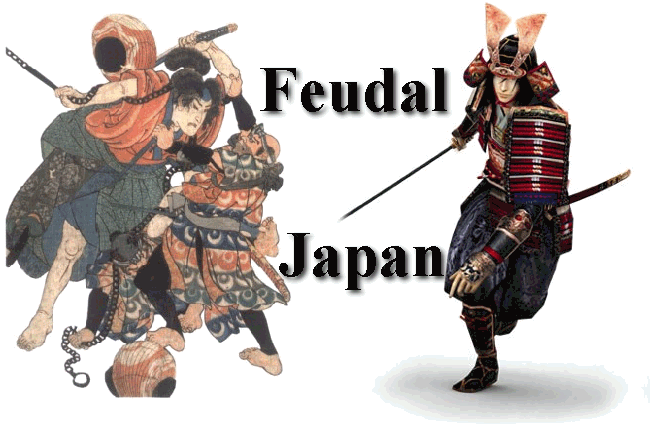
1. Read the following and study the diagram
showing the hierarchical feudal structure of
medieval Japan.
Then under the above heading, write out the sentences in
italics below
the diagram of their feudal system.
What is feudalism?
A country is often too big for a King to
control on his own.
Feudal or feudalism is a type of government where the King or Emperor
divides up the land and gives areas of
land (fiefs) to his Lords or
Barons (called Daimyo in Japan) to look after.
The Lords (Daimyo) promise in return to
pay some tax money to the
Emperor each year,
and be loyal to
Emperor and help him in times
of war.
If some Lords (Daimyo) are given too much land to control on
their own, they gave some of their land to their
faithful and loyal
knights (called Samurai in Japan) to look
after.
The Knights (Samurai) promise in return to
pay some tax money to their Lord (Daimyo) each year,
and be loyal to
their Lord
(Daimyo)
and
fight for him in times
of war.
Across the country peasants are given land to grow food, and in
return for this and protection, they give some of
their food each year
to their local Lord (Daimyo or Samurai.)
The lower the level in this social class structure, the less power and
influence the people have. In Medieval Japan the
classes lower than the
peasants were the artisans (craftsmen), merchants and Eta.
They were the lowest because they produced no food for themselves.
 |
||
|
Explain why the merchants were lower than the peasants in social status in the feudal system in medieval Japan.
|
religious Feudalism
Civil
Yamato
land
700
Emperor
Shogun
peasants
1336
Samurai |
Use the following web site to help you and write your notes in your book.
(https://sites.google.com/site/mrvailsclass2/feudal-japan )
• Until 1185 an ______________ruled all of Japan.
• He was also a ______________ leader and was thought to have descended from a God.
• The Emperor had armies of _______________ warriors, however, he was defeated by a
group of Daimyo Lords in a ________ war in the year ______
 |
• So he would not lose his throne, the Emperor made the head Daimyo _____________ or
chief military leader of all of Japan.
• This began a new form of control in Japan, where the Daimyo leaders with their
samurai armies controlled small areas of the land, rather than one emperor controlling
everything - this is usually called Feudal control or _____________
Map of Feudal Japan showing the lands belonging to the different Feudal Lords or Daimyo.
• The wealthy Daimyo landholders relied on ___________ (serfs) to farm the land similar to Medieval Europe.
• Some of the Daimyo’s Samurai were also given smaller pieces of _______ to control with the help
of their own peasants.
• The ___________ family remained as emperor. He appeared at ceremonies, celebrations, and parades, but
the emperor had no real control over the people.
• During the next ________ years of Feudal Japan, different shoguns (shogunates) controlled Japan.
4. a) Compare this diagram of the hierarchical feudal system in medieval England with the Japanese feudal system.
Briefly note the ways in which the two systems were similar.
b) Conduct your own research into the Samurai and then print off and complete this
Venn diagram comparing the Japanese Samurai with European Medieval Knights.
This page would be a good place to sstart.
You could work in pairs and help each other to find similarities and differences.
 |
5. Write the following points in
your book under the heading:
•
In 1603 Tokugawa Ieyasu became Shogun and their family ruled japan with strict
controls for 264 years.
• The
Tokugawa Shogun moved his capital to Edo (now called Tokyo) - This period from 1603 to 1868
is known as the Tokugawa Period or the Edo Period.
|
7
Use this web page to find information to fill in your chart. Paste it in
your book when complete.
